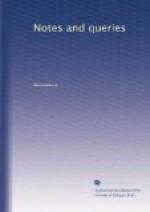NOTES
Etymology of Penniel.
Some eighteen years ago, the writer of the following sonnets, by the kindness of the proprietors of a pleasant house upon the banks of the Teviot, enjoyed two happy autumns there. The Roman road which runs between the remains of the camp at Chew Green, in Northumberland, and the Eildon Hills (the Trimontium of General Roy), passed hard by. The road is yet distinctly visible in all its course among the Cheviots, and in the uncultivated tracts; and occasionally also, where the plough has spared it, among the agricultural inclosures.
The house stands near the base of the hill called Penniel or Penniel-heugh: and it is hoped that the etymological derivation of that word now to be hazarded will not imply in the etymologist the credulity of a Monkbarns. Pen, it is known, signifies in the Celtic language “a hill”. And the word heil, in the Celto-Scythian, is, in the Latin, rendered Sol. In the Armoric dialect of the Celtic also, heol means “the sun:” hence, Penheil, Penheol, or Penniel, “the hill of the sun.” Beyond the garden of the abode there stood, and, it is believed, yet stands, a single stone of a once extensive Druid circle, not many years ago destroyed by the then proprietor, who used the sacred remains in building his garden wall. A little farther antiquarian conjecture is necessary to clothe the country with oak woods. Jedwood or Jedworth Forest was part of “the forest” which covered Selkirkshire and parts of the counties around. The Capon Tree, and the King of the Wood, two venerable oaks yet flourishing on the water of Jed, attest the once wooded condition of the land; which is farther irresistibly corroborated by evidence drawn from the interesting volumes of the Rotuli Parliamentorum. The Bishops of Glasgow had a religious establishment in the neighbouring sunward village of Nether Ancrum. Of their buildings, of the vicar’s house, or of the ancient gardens existing in the memory of persons living, not a vestige now remains. In the first volume of the Rotuli, p. 472., there is a Petition, of uncertain date, by the Bishop of Glasgow to Edward I., then in possession of Scotland, in these terms:—
“Derechief pry ly dit Evesqe a soen Segur le Roy qe ly plese aider &c.... e sur ceo transmettr’, sa lettre al vesconte de Lanark. E une autre, si ly plest, a ses Forresters de Geddeworth de autant de Merin [meremium, meheremium, wood for building] pour fere une receite a Allyncrom (Ancrum) desur la marche, ou il poet aver recett e entendre a ses ministres qut il le voudrent aver.”
To which the King’s answer is,—
“Heat Bre Ten’
locu R. in Scoc. qd fae’. ei hre meheremiu in
Foresta de Selkirk et de Maddesleye
usq ad numum quinquaginta
quercu.”
Thus, no doubt is left that oak woods abounded in the district; and it was under the influence of these beliefs that the sonnets were composed:—




